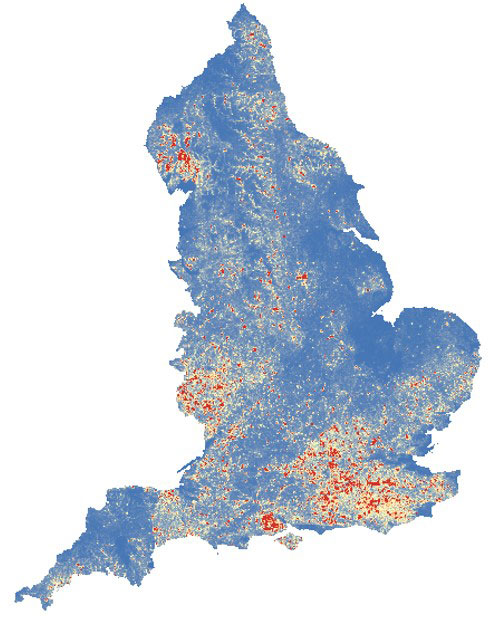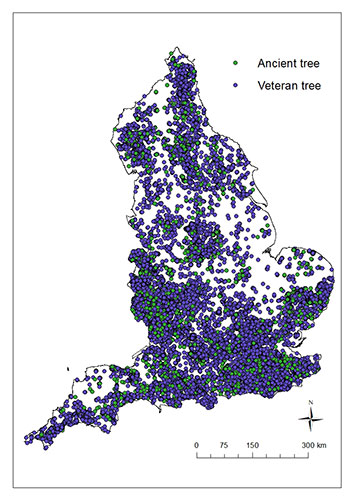A new study has shown there could be around eight to ten times as many ancient and veteran trees in England than currently recorded, with estimates ranging from 1.7 to 2.1 million, compared to the 115,000 currently on record.
As many of these trees are yet to be recorded, most are not likely to be protected by conservation methods, policy or legislation, and therefore we don't know how many are at risk, why, or where. New location mapping, developed by experts at the University of Nottingham, means work towards recording and mapping them could become easier.
The new research builds upon work carried out by the Woodland Trust, Ancient Tree Forum and the Tree Register, which has currently mapped 180,000 trees.
In this new study, published in Ecological Applications, experts from the School of Life Sciences at the University teamed up1 with the Woodland Trust, to develop the first robust nationwide estimate of ancient and veteran trees in England.
An ancient tree is a tree that shows exceptional age in relation to other trees of the same species. Most ancient and veteran trees display similar features such as a hollowing trunk, dead wood in the canopy or the presence of other organisms such as fungi or plants on its structure. They may also have irreplaceable historical or cultural value. Veteran trees share similar features and values to ancient trees, but they may not be old enough to be considered truly ancient for their species.
Birch trees for example, are fast-growing and could be classed as ancient at 150 years old, while a yew tree might receive the same accolade at 800 years of age. These trees are very important sources of dead wood that are valuable natural assets important for wildlife. They also have cultural and historical links, and some of the oldest trees in the country e.g. the Major Oak in Sherwood Forest, Nottinghamshire, are busy tourist spots.
Whilst an ancient tree may have legal protection if it provides a home to another protected species, the categorisation as an ancient or veteran tree does not actually provide protection alone, so identifying where these trees are is essential in order to set about increasing their protection.
Currently there is no legal protection for ancient or veteran trees unless they have a Tree Preservation Order, usually applied in emergency situations, or they are located within a legally protected wildlife site. Around 20% of ancient and veteran trees are located in sites like this so most ancient and veteran trees have no form of legal protection and policies need strengthening across the UK, for example to protect old trees in new developments.

The overall aim of the team's research was to create a distribution map to predict where hotspots of these trees might be, to help the Woodland Trust, and other recorders, to have a more targeted approach to surveys, saving time and resources. Using the Woodland Trust's Ancient Tree Inventory (ATI), the team created a number of different mathematical models, called species distribution models. The models used a variety of environmental, human and historical characteristics to predict the true distribution of ancient and veteran tree distribution across England.
The aim of the ATI is to identify and map the oldest trees in the UK, and was started in 2004. Anyone can record a tree online (https://ati.woodlandtrust.org.uk), with each entry then verified by experts.
Within the ATI there is likely to be what is known as 'sampling bias', where the actual distribution of records collected is partly a reflection of where people have gone to survey, rather than where the trees actually might be.

To combat sampling bias, some of the models used predictors such as distance from cities, distance from roads, and population density, as well as the environmental factors, to help distinguish between places where people are unlikely to have looked for trees and places which really don't have any.
The aim was to select the best model that produced the map that was most reflective of the real tree distribution. In order to check the reliability of the maps, a group of volunteers was then recruited to carry out a selection of surveys to locate the trees.
Each volunteer was asked to survey one or more randomly selected 1km square grids as thoroughly as possible to find all the ancient and veteran trees in that square, with the results being used to help select the best model. Fifty-two square grids were surveyed in total covering 52 km2 across England. A total of 459 trees were found, 94 of which were ancient and 365 of which were veteran.
Many volunteers also reported a high likelihood of more trees in areas that were inaccessible or too far off to survey accurately. Therefore, these numbers are very likely to be underestimates of the number of valuable ancient and veteran trees out there.
When cross-checked with the ATI, 285 of the trees found during these surveys were not previously recorded on the ATI, which means there was over a 100% increase in the number of trees known about across these squares. Many of these trees have now been added to the ATI, which will help the Woodland Trust to keep up-to-date with their condition and help to protect them if necessary.
Before the surveys only 15 squares had any records of ancient or veteran trees, but after the surveys that total rose to 38 squares (23 squares more).
A total of 22 species of trees were recorded across all the surveys, with Oak being by far the most commonly recorded (54% of identified trees), followed by Ash (12%), Beech (6%) and Sycamore (5%).
The findings from the surveys provide an insight into the number of species and type of trees that are present in different areas of the country. They also were able to be used to calibrate the models and provide estimates of the total number of ancient and veteran trees across England.
She added: "Based on the best performing distribution models, these estimates predict two million ancient and veteran trees, which is an amazing increase on what is currently recorded. It also suggests there is a lot more recording to do, but by having these more accurate prediction maps, targeted surveying will make it much easier to find them!"
Adam Cormack, Head of Campaigning at the Woodland Trust said: "It's remarkable that this research suggests we are yet to find most of the UK's ancient trees, the cathedrals of the natural world. They're out there somewhere - hidden in field corners, woods, hedges, even gardens and parks. Volunteers have done an amazing job to map thousands so far and this research is the inspiration to redouble our efforts. It's like a map for buried treasure. But it's also worrying because these trees don't have the automatic legal protection that most of our wildlife and old buildings have. This is despite the fact some are more than 1,000 years old. These astonishing trees are our inheritance from history, and we should be treating them like national treasures. We are petitioning governments across the UK for better protection for our most ancient and important trees and to do more to support people who are looking after them."






